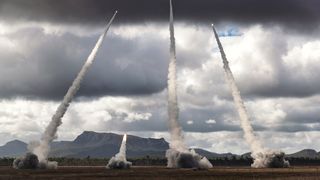Ever since Russia’s illegal invasion of Ukraine, the Ukrainian military has shown great resilience and ability to stand firm in the face of a much better resourced adversary.
One key factor has been innovation. Ukrainian soldiers have proven highly adept at using applications of commercial technologies to support military effects. This includes “Uber for artillery” and equipping drones with grenades, right through to the use of SpaceX Starlink satellites for communications. For Australia, the rapid and open approaches to innovation in Ukraine are instructive for quickly bolstering our nation’s military edge.
By this weekend, the government will have put in place its response to improve defence innovation, the Advanced Strategic Capabilities Accelerator. In a new report published by the University of Western Australia’s Defence and Security Institute this week, however, I argue ASCA is only a partial solution to the challenges facing defence innovation. Without broader and more ambitious reforms, there is a risk the Australian military may be ill-prepared for a potential contingency in our region. Australia finds itself in a more dangerous Indo-Pacific region. With US-China competition continuing to intensify, the 2023 Defence Strategic Review makes it clear Australia has lost its warning time of 10 years for the possibility of major conflict.
Existing institutional structures and culture shaping defence innovation require disruption and reform.
Existing institutional structures and culture shaping defence innovation require disruption and reform. This must be guided by clear strategy and supported by closer partnerships with industry and academia, international collaboration and funding.
Amid growing strategic uncertainty, a technological edge is critical to Australia’s defence strategy of deterrence by denial. The ADF requires lethal asymmetric capabilities across the domains of air, land, maritime, space and cyber that can increase the cost of aggression by adversaries against Australia and its interests. But when advanced capabilities have never been more important to national security, Australia and its closest partners, such as the US, are under increased pressure.
The Australian Strategic Policy Institute’s Critical Technology Tracker found China leads high-impact research for 19 of 23 critical technologies that are relevant to the AUKUS strategic partnership between Australia, the US and UK. China is judged to have a “commanding lead” in hypersonics, electronic warfare and undersea capabilities.
Regaining leadership in defence-relevant research is but one step to secure Australia’s technological edge. What is also important is how that research is translated for practical military effect through innovation. Australia is taking modest steps to strengthen its approach to defence innovation. This follows successive attempts at reform, including following the 2015 First Principles Review. ASCA aims to fast-track the translation of nationally significant science and technology research into game-changing military applications. This is consistent with similar models in the US, UK, Germany, Japan and NATO countries, among others.
ASCA is a step in the right direction, but it will not be a panacea for wider institutional, bureaucratic and cultural challenges impeding defence innovation outcomes. ASCA will have a limited impact on funding, with $3.4bn committed to ASCA over the next decade. This results in a net increase in defence innovation spending of $557m.
The Department of Defence still only spends about 3 per cent of its budget on innovation. In comparison, the US spends 13 per cent and the UK spends 7 per cent.
My report recommends that Australia needs to refresh its defence innovation strategy as part of the National Defence Strategy process in 2024.
The Department of Defence still only spends about 3 per cent of its budget on innovation. In comparison, the US spends 13 per cent and the UK spends 7 per cent.
The last defence innovation strategy was released in 2020, before AUKUS, the Defence Innovation Review, the Defence Strategic Review, the fallout of the COVID-19 pandemic, Russia’s invasion of Ukraine and intensifying great power competition.
Framed by a clear vision for defence innovation in this country, a refreshed strategy should identify priorities with a clear line to policies, programs, and funding. Getting capability into the hands of the war fighter more quickly must be the strategy’s north star. The strategy should consider how Defence can use an open innovation model to re-purpose commercial technology, informed by lessons from Ukraine and recent moves in the US to allocate US$1 billion to better use commercially available systems for defence.
There are many steps Defence can take in the meantime to support ASCA’s success. ASCA needs a focused mission, flexible procurement approaches, and visionary leaders from diverse backgrounds who have the courage to take risks.
ASCA should seek to institutionalise closer collaboration with the private sector and academia. A secondment program for non-government stakeholders could be used to fill some key ASCA leadership positions, including from partner nations such as the US. International scientific collaboration will remain a critical component of Defence’s approach to innovation. ASCA could provide the institutional home for AUKUS technology acceleration activities and support novel arrangements such as the Allied Nations Defence Industrial Base Accelerator platform between the US, Japan, UK, Australia, India and NATO countries.
Australia cannot pursue similar approaches to defence innovation and expect a different result. Only transformational change will yield transformational results.
The question is not whether more ambitious reforms are needed, but just how quickly they can be enacted to protect and advance Australia’s national interest.






